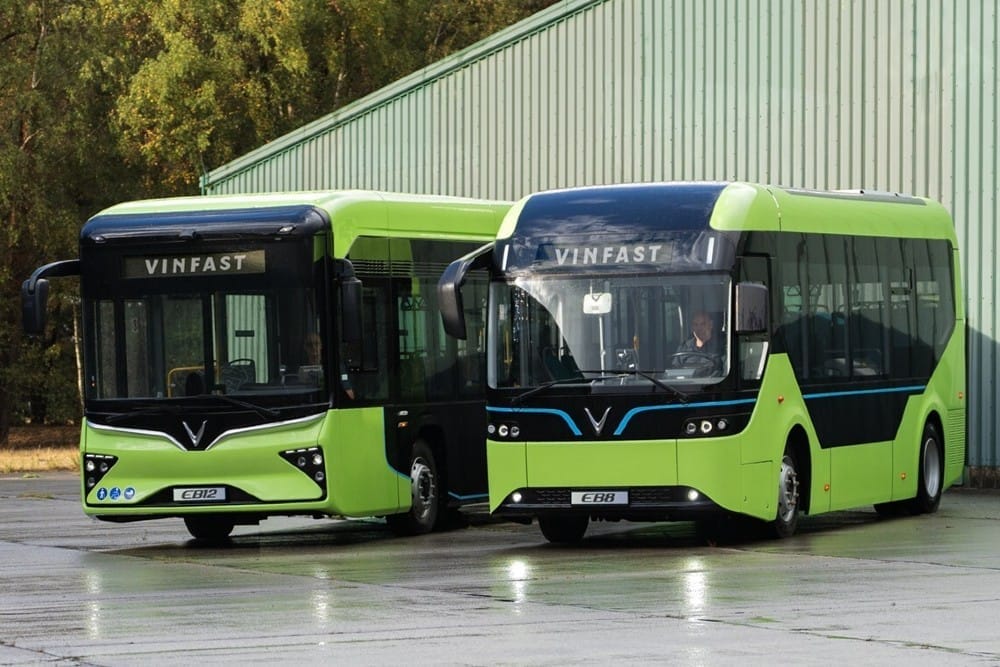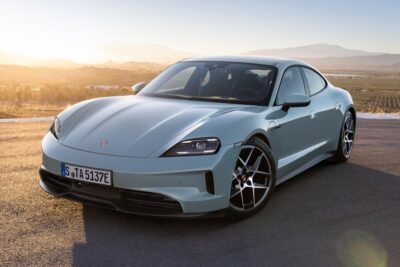VinFast presents EB 12 and EB 8 electric city buses
VinFast has been operating electric buses in Vietnam for four years, while the OEM has so far only been active as a passenger car manufacturer in Europe. That is now changing: visitors to Busworld in Brussels (4–9 October) will be able to see VinFast’s EB 8 and EB 12 for the first time. The former is an 8.6-metre-long midibus, the latter a solo bus in the classic 12-metre format; both are purely electric and are now also looking for buyers in Europe. The EB 12 is also available to order now and, according to Vietnam, will be manufactured in a “state-of-the-art production facility” in Vietnam with a capacity of 1,500 to 2,000 units per year. VinFast is aiming for the first deliveries in 2026.
About the model itself: The VinFast EB 12 measures 12.11 x 2.55 x 3.33 metres with a wheelbase of 5.90 metres and a gross vehicle weight of 19.2 tonnes. The low-floor bus has three doors and space for up to 90 passengers (35 seats, 1 wheelchair space and 54 standing places), with the interior being individually configurable. The EB 12’s electric drive consists of two wheel hub motors, each with 125 kW, which together deliver a maximum output of 250 kW and propel the bus to a top speed of 80 km/h. The battery has an energy content of 422 kWh, which, according to earlier information, consists of LFP batteries from “proven global leaders such as CATL and Gotion.” The Vietnamese manufacturer states the range as over 400 km according to SORT 2, with a DC charging capacity of 140 kW.
Other features on board include a range of driver assistance systems, dual-zone automatic climate control with a heat pump, and air suspension on the front and rear axles. The interior also has 26 USB charging ports, video surveillance, and an LED light strip.
The EB 8 is a smaller bus version measuring 8.61 x 2.47 x 3.22 metres and, unlike the EB 8, uses a central electric motor with an output of 200 kW. The battery capacity is 359 kWh for a range of around 290 kilometres (SORT 1). The EB 8 can charge at a maximum of 120 kW at fast charging stations. Inside, the midibus can accommodate up to 60 passengers, including 24 seats, one wheelchair space and 35 standing places. In addition to an ADAS package, VinFast lists full air suspension, single-zone automatic climate control and a standard electric wheelchair ramp for the EB 8.
While the EB 12 already complies with UNECE and CE regulations and can be ordered in Europe with immediate effect, the smaller EB 8 is set to ‘follow at a later date’. VinFast will offer a five-year warranty with unlimited mileage on the entire vehicle for both the EB 8 and EB 12. “Meanwhile, the battery and the anti-corrosion body protection are covered for up to 8 years, also with no mileage limit,” according to an accompanying statement.
Le Thi Thu Thuy, Vice Chairwoman of Vingroup and Chairwoman of VinFast, commented: “VinFast was founded with the aspiration of democratizing electric mobility. Through our comprehensive product ecosystem, ranging from personal cars to buses, we stand ready to collaborate with individuals, corporate partners, and communities worldwide. We are confident that VinFast’s modern, high-performance, and amenity-rich electric buses will be the ideal choice for both operators and their passengers, actively contributing to a greener and safer transportation future for all.”
In addition to its electric buses, VinFast is also unveiling its strategy for entering the European public transport market at the trade fair in Brussels. The company specifically states that it intends to focus on partnerships with European specialists and suppliers in the transport and infrastructure sectors. This approach is to be based on the introduction of its own electric cars, which in Europe include the VF 6 and VF 8 models. VinFast restructured its sales organisation in the passenger car sector this year.
The bus segment is expected to perform better right from the start. To this end, VinFast intends to establish strategic partnerships “to build a distribution network for its electric buses in key markets such as Germany, the Netherlands, Belgium, Sweden, Central and Eastern European countries and the Baltic states.”
This article was first published by Cora Werwitzke for electrive’s German edition





0 Comments